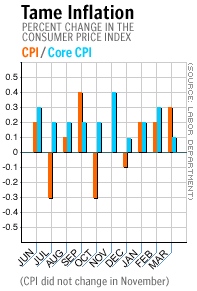
NEW YORK (CNN/Money) -
Consumer prices edged up in the United States in March, the government said Tuesday, though inflation remained a distant threat at the end of the economy's first recession in a decade.
Meanwhile, new home construction cooled off in March as the robust housing market retreated from big gains in February, and industrial production gained strength.
The Labor Department said the Consumer Price Index, the government's main inflation gauge, rose 0.3 percent in March after rising 0.2 percent in February. Economists surveyed by Briefing.com expected CPI to rise 0.5 percent.
Excluding often volatile food and energy prices, the "core" CPI rose 0.1 percent after rising 0.3 percent in February. Economists surveyed by Briefing.com expected core CPI to rise 0.2 percent.
"There is no near-term inflation threat here," said Ian Shepherdson, chief U.S. economist at High Frequency Economics Ltd.

Separately, the Commerce Department said the pace of housing starts fell 7.8 percent in March to an annual rate of 1.65 million units from a revised 1.78 million unit rate in February. Economists surveyed by Briefing.com expected a 1.70 million unit rate in March.
It was the biggest one-month drop for housing starts since a 9.3 percent decline in February 1990, but last month's level was also the highest since December 1998.
"No doubt housing activity was elevated over the winter because of very, very mild weather," Charles Lieberman, chief economist and chief investment strategist at Advisors Financial, told CNNfn's Before Hours program. "One housing start in Syracuse, N.Y., in December is an awful lot. So we shouldn't be surprised by a big fall-off."
New building permits, an indication of builders' expectations for future activity, fell 9.9 percent to a 1.6 million unit rate in March, compared with a revised 1.77 million rate in February. Economists surveyed by Briefing.com expected a 1.685 million rate in March.
Separately, the Federal Reserve said industrial production rose 0.7 percent in March after a revised 0.3 percent increase in February. Economists surveyed by Briefing.com expected industrial production to rise 0.5 percent. It was the biggest gain for industrial production since March 2000.
The Fed, the nation's central bank, said factories used 75.4 percent of their capacity in March, above February's revised level of 74.9 percent. Economists surveyed by Briefing.com expected capacity utilization to come in at 75.1 percent.
The gain in production was led by a 0.8 percent gain in factory production, also the best performance since March 2000. It was the latest sign of recovery in the manufacturing sector, which suffered through an 18-month recession that the Institute of Supply Management said finally ended in February.
U.S. stock prices rose in early trading, while Treasury bond prices fell.
Inflation has been relatively tame for some time, especially during a recession in the broader economy that the National Bureau of Economic Research said began in March 2001.
To fight the recession and keep consumers spending, the Federal Reserve cut its target for short-term interest rates 11 times in 2001.
| |
 Related links
Related links
| |
| | |
| | |
|
The Fed left rates alone at its first two policy meetings of 2002, and some observers have speculated that it could start to raise rates again soon this year to fight inflation.
But Tuesday's CPI data, coming on the heels of an uptick in the unemployment rate in March and other evidence of a less-than-robust recovery, are further evidence that the Fed might be willing to leave rates lower for longer.
"Generally I think these numbers could reduce some of the concerns about a quick or dramatic change in Fed policy," Gary Thayer, chief economist at A.G. Edwards & Sons, told Reuters.
Much of the gain in consumer prices was due to a 3.8 percent gain in energy prices, including an 8 percent jump in gasoline prices. Oil prices have surged in recent weeks, driven by intensifying violence in the Middle East and political turmoil in Venezuela, the world's No. 4 oil exporter.

|

